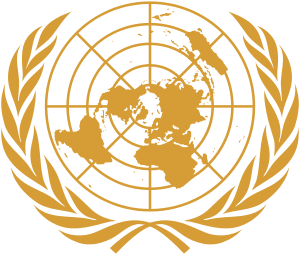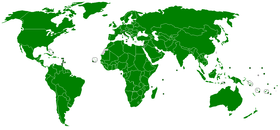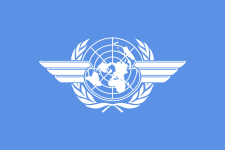International Civil Aviation Organization
|
International Civil Aviation Organization | |
 | |
|
ICAO flag | |
| Abbreviation |
ICAO OACI ИКАО 国际民航组织 إيكاو |
|---|---|
| Formation | 4 April 1947[1] |
| Type | UN specialized agency |
| Legal status | Active |
| Headquarters | Montreal, Quebec, Canada |
Head |
Fang Liu Secretary General |
| Website |
www |
The International Civil Aviation Organization (ICAO) (pronounced /aɪˈkeɪ.oʊ/; French: Organisation de l'aviation civile internationale, OACI), is a specialized agency of the United Nations. It codifies the principles and techniques of international air navigation and fosters the planning and development of international air transport to ensure safe and orderly growth.[2] Its headquarters are located in the Quartier International of Montreal, Canada.
The ICAO Council adopts standards and recommended practices concerning air navigation, its infrastructure, flight inspection, prevention of unlawful interference, and facilitation of border-crossing procedures for international civil aviation. ICAO defines the protocols for air accident investigation followed by transport safety authorities in countries signatory to the Convention on International Civil Aviation (Chicago Convention).
The Air Navigation Commission (ANC) is the technical body within ICAO. The Commission is composed of 19 Commissioners, nominated by the ICAO's contracting states, and appointed by the ICAO Council.[3] Commissioners serve as independent experts, who although nominated by their states, do not serve as state or political representatives. The development of Aviation Standards and Recommended Practices is done under the direction of the ANC through the formal process of ICAO Panels. Once approved by the Commission, standards are sent to the Council, the political body of ICAO, for consultation and coordination with the Member States before final adoption.
ICAO is distinct from other international air transport organizations, like the International Air Transport Association (IATA), a trade association representing airlines; the Civil Air Navigation Services Organisation (CANSO), an organization for Air Navigation Service Providers (ANSPs); and the Airports Council International, a trade association of airport authorities.
History
The forerunner to ICAO was the International Commission for Air Navigation (ICAN).[2] It held its first convention in 1903 in Berlin, Germany but no agreements were reached among the eight countries that attended. At the second convention in 1906, also held in Berlin, 27 countries attended. The third convention, held in London in 1912 allocated the first radio callsigns for use by aircraft. ICAN continued to operate until 1945.[4][5]
Fifty-two countries signed the Convention on International Civil Aviation, also known as the Chicago Convention, in Chicago, Illinois, on 7 December 1944. Under its terms, a Provisional International Civil Aviation Organization (PICAO) was to be established, to be replaced in turn by a permanent organization when 26 countries ratified the convention. Accordingly, PICAO began operating on 6 June 1945, replacing ICAN. The 26th country ratified the Convention on 5 March 1947 and, consequently PICAO was disestablished on 4 April 1947 and replaced by ICAO, which began operations the same day. In October 1947, ICAO became an agency of the United Nations linked to the United Nations Economic and Social Council (ECOSOC).[1][4]
In April 2013 Qatar offered to serve as the new permanent seat of the Organization. Qatar promised to construct a massive new headquarters for ICAO and cover all moving expenses, stating that Montreal "was too far from Europe and Asia", "had cold winters," was hard to attend due to the refusal of the Canadian government to provide visas in a timely manner, and that the taxes imposed on ICAO by Canada were too high.[6] According to the Globe and Mail, Qatar's move was at least partly motivated by the pro-Israel foreign policy of Canadian Prime Minister Stephen Harper.[7][8] Approximately one month later, Qatar withdrew its bid after a separate proposal to the ICAO's governing council to move the ICAO triennial conference to Doha was defeated by a vote of 22–14.[9][10][11]
Statute
The 9th edition of the Convention on International Civil Aviation includes modifications from 1948 up to year 2006. ICAO refers to its current edition of the Convention as the Statute, and designates it as ICAO Document 7300/9. The Convention has 19 Annexes that are listed by title in the article Convention on International Civil Aviation.[12]
Membership

As of March 2016, there are 191 ICAO members, consisting of 190 of the 193 UN members (all but Dominica, Liechtenstein, and Tuvalu), plus the Cook Islands.[13][14]
Liechtenstein has delegated Switzerland to implement the treaty to make it applicable in the territory of Liechtenstein.[15]
Taiwan attended the 38th Session of the ICAO Assembly in 2013, but in 2016 was denied such an invitation (possibly due to political pressure from the People's Republic of China), despite expressions of support from the United States for Taiwan to participate.[16] However, Republic of China under the name of Chinese Taipei is a member of International Air Transport Association.
Council
The Council of ICAO is elected by the Assembly every 3 years and consists of 36 members elected in 3 categories. The present Council was elected on 1 October 2013 at the 38th Assembly of ICAO at Montreal.[17] The structure of the present Council is as follows:
PART I – (States of chief importance in air transport) – Australia*, Brazil*, Canada*, China*, France*, Germany*, Italy*, Japan*, Russian Federation*, United Kingdom*, and the United States*.[18]
PART II – (States which make the largest contribution to the provision of facilities for international civil air navigation) – Argentina*, Colombia, Egypt*, India*, Ireland, Mexico*, Nigeria*, Saudi Arabia*, Singapore*, South Africa*, Spain* and Sweden.[19]
PART III– (States ensuring geographic representation)- Algeria, Cabo Verd, Congo, Cuba, Ecuador, Kenya*, Malaysia*, Panama, Republic of Korea*, Turkey, United Arab Emirates*, United Republic of Tanzania*, and Uruguay. [20] * Indicates re-election.
Standards

Top: ICAO acronym in English, French/Portuguese/Spanish, and Russian.
Bottom: ICAO acronym in Chinese and Arabic
ICAO also standardizes certain functions for use in the airline industry, such as the Aeronautical Message Handling System (AMHS). This makes it a standards organization.
Each country should have an accessible Aeronautical Information Publication (AIP), based on standards defined by ICAO, containing information essential to air navigation. Countries are required to update their AIP manuals every 28 days and so provide definitive regulations, procedures and information for each country about airspace and airports. ICAO's standards also dictate that temporary hazards to aircraft are regularly published using NOTAMs.
ICAO defines an International Standard Atmosphere (also known as ICAO Standard Atmosphere), a model of the standard variation of pressure, temperature, density, and viscosity with altitude in the Earth's atmosphere. This is useful in calibrating instruments and designing aircraft.[21]
ICAO standardizes machine-readable passports worldwide.[22] Such passports have an area where some of the information otherwise written in textual form is written as strings of alphanumeric characters, printed in a manner suitable for optical character recognition. This enables border controllers and other law enforcement agents to process such passports quickly, without having to enter the information manually into a computer. ICAO publishes Document 9303 Machine Readable Travel Documents, the technical standard for machine-readable passports.[23] A more recent standard is for biometric passports. These contain biometrics to authenticate the identity of travellers. The passport's critical information is stored on a tiny RFID computer chip, much like information stored on smartcards. Like some smartcards, the passport book design calls for an embedded contactless chip that is able to hold digital signature data to ensure the integrity of the passport and the biometric data.
ICAO is active in infrastructure management, including Communication, Navigation, Surveillance / Air Traffic Management (CNS/ATM) systems, which employ digital technologies (like satellite systems with various levels of automation) in order to maintain a seamless global air traffic management system.[24]
Registered codes
Both ICAO and IATA have their own airport and airline code systems. ICAO uses 4-letter airport codes (vs. IATA's 3-letter codes). The ICAO code is based on the region and country of the airport—for example, Charles de Gaulle Airport has an ICAO code of LFPG, where L indicates Southern Europe, F, France, PG, Paris de Gaulle, while Orly Airport has the code LFPO (the 3rd letter sometimes refers to the particular flight information region (FIR) or the last two may be arbitrary). In most of the world, ICAO and IATA codes are unrelated; for example, Charles de Gaulle Airport has an IATA code of CDG. However, the location prefix for continental United States is K and ICAO codes are usually the IATA code with this prefix. For example, the ICAO code for Los Angeles International Airport is KLAX. Canada follows a similar pattern, where a prefix of C is usually added to an IATA code to create the ICAO code. For example, Calgary International Airport is YYC or CYYC. (In contrast, airports in Hawaii are in the Pacific region and so have ICAO codes that start with PH; Kona International Airport's code is PHKO. Similarly, airports in Alaska have ICAO codes that start with PA. Merrill Field, for instance is PAMR.) Note that not all airports are assigned codes in both systems; for example, airports that do not have airline service do not need an IATA code.
ICAO also assigns 3-letter airline codes (versus the more-familiar 2-letter IATA codes—for example, UAL vs. UA for United Airlines). ICAO also provides telephony designators to aircraft operators worldwide, a one- or two-word designator used on the radio, usually, but not always, similar to the aircraft operator name. For example, the identifier for Japan Airlines International is JAL and the designator is Japan Air, but Aer Lingus is EIN and Shamrock. Thus, a Japan Airlines flight numbered 111 would be written as "JAL111" and pronounced "Japan Air One One One" on the radio, while a similarly numbered Aer Lingus would be written as "EIN111" and pronounced "Shamrock One One One". In the US, FAA practices[25] require the digits of the flight number to be spoken in group format ("Japan Air One Eleven" in the above example) while individual digits are used for the aircraft tail number used for unscheduled civil flights.
ICAO maintains the standards for aircraft registration ("tail numbers"), including the alphanumeric codes that identify the country of registration. For example, airplanes registered in the United States have tail numbers starting with N.
ICAO is also responsible for issuing alphanumeric aircraft type codes containing two to four characters. These codes provide the identification that is typically used in flight plans. The Boeing 747 would use B741, B742, B743, etc., depending on the particular variant.
Regions and regional offices
ICAO has a headquarters, seven regional offices, and one regional sub-office :[26]
- Headquarters – Montreal, Quebec, Canada
- Asia and Pacific (APAC) – Bangkok, Thailand; Sub-office – Beijing, China
- Eastern and Southern African (ESAF) – Nairobi, Kenya
- Europe and North Atlantic (EUR/NAT) – Paris, France
- Middle East (MID) – Cairo, Egypt
- North American, Central American and Caribbean (NACC) – Mexico City, Mexico
- South American (SAM) – Lima, Peru
- Western and Central African (WACAF) – Dakar, Sénégal
Leadership
List of Secretaries General
| Secretar | From | Term |
|---|---|---|
| Fang Liu | | 2015– |
| Raymond Benjamin | | 2009–2015 [27] |
| Taïeb Chérif | | 2003–2009 |
| Renato Claudio Costa Pereira | | 1997–2003 |
| Philippe Rochat | | 1991–1997 |
| Shivinder Singh Sidhu | | 1988–1991 |
| Yves Lambert | | 1976–1988 |
| Assad Kotaite | | 1970–1976 |
| Bernardus Tielman Twigt | | 1964–1970 |
| Ronald MacAllister Macdonnell | | 1959–1964 |
| Carl Ljungberg | | 1952–1959 |
| Albert Roper | | 1944–1951 |
List of Council Presidents
| President | From | Term |
|---|---|---|
| Olumuyiwa Benard Aliu | | 2013–present |
| Roberto Kobeh Gonzalez | | 2006–2013 |
| Assad Kotaite | | 1976–2006 |
| Walter Binaghi | | 1957–1976 |
| Edward Pearson Warner | | 1947–1957 |
ICAO and climate change
Emissions from international aviation are specifically excluded from the targets agreed under the Kyoto Protocol. Instead, the Protocol invites developed countries to pursue the limitation or reduction of emissions through the International Civil Aviation Organization. ICAO's environmental committee continues to consider the potential for using market-based measures such as trading and charging, but this work is unlikely to lead to global action. It is currently developing guidance for states who wish to include aviation in an emissions trading scheme (ETS) to meet their Kyoto commitments, and for airlines who wish to participate voluntarily in a trading scheme.
Emissions from domestic aviation are included within the Kyoto targets agreed by countries. This has led to some national policies such as fuel and emission taxes for domestic air travel in the Netherlands and Norway, respectively. Although some countries tax the fuel used by domestic aviation, there is no duty on kerosene used on international flights.[28]
ICAO is currently opposed to the inclusion of aviation in the European Union Emission Trading Scheme (EU ETS). The EU, however, is pressing ahead with its plans to include aviation.
Agreement on CO2 emissions from international aviation, October 2016
On October 6, 2016, the ICAO finalized an agreement among its 191 member nations to address the more than 1000 t of carbon dioxide emitted annually by international passenger and cargo flights. The agreement will use an offsetting scheme called CORSIA (the Carbon Offsetting and Reduction Scheme for International Aviation) under which forestry and other carbon-reducing activities are directly funded, amounting to about 2% of annual revenues for the sector. Rules against 'double counting' should ensure that existing forest protection efforts are not recycled. The scheme does not take effect until 2021 and will be voluntary until 2027, but many countries, including the US and China, have promised to begin at its 2020 inception date. Under the agreement, the global aviation emissions target is an 80% reduction by 2035 relative to 2020. NGO reaction to the deal was mixed.[29][30][31]
The agreement has critics. It is not aligned with the 2015 Paris climate agreement, which set the objective of restricting global warming to 1.5 to 2°C. A late draft of the agreement would have required the air transport industry to assess its share of global carbon budgeting to meet that objective, but the text was removed in the agreed version.[32][33] CORSIA will regulate only about 25 percent of aviation's international emissions, since it grandfather's all emissions below the 2020 level, allowing unregulated growth until then.[34] Only 65 nations will participate in the initial voluntary period, not including significant emitters Russia, India and perhaps Brazil. The agreement does not cover domestic emissions, which are 40% of the global industry's overall emissions.[33] One observer of the ICAO convention made this summary:
Airline claims that flying will now be green are a myth. Taking a plane is the fastest and cheapest way to fry the planet and this deal won't reduce demand for jet fuel one drop. Instead offsetting aims to cut emissions in other industries,
although another critic called it "a timid step in the right direction."[35]
Investigations of air disasters
Most air accident investigations are carried out by an agency of a country that is associated in some way with the accident. For example, the Air Accidents Investigation Branch conducts accident investigations on behalf of the British Government. ICAO has conducted three investigations involving air disasters, of which two were passenger airliners shot down while in international flight over hostile territory.
- Libyan Arab Airlines Flight 114 which was shot down on 21 February 1973 by Israeli F-4 jets over the Sinai Peninsula during a period of tension that led to the Arab-Israeli Yom Kippur War killing 108 people.
- Korean Air Lines Flight 007, which was shot down on 1 September 1983 by a Soviet Su-15 interceptor near Moneron Island just west of Sakhalin Island during a period of heightened Cold War tension killing all 269 people on board including U.S. Congressman Larry McDonald.[36]
- UTA Flight 772, which was destroyed by a bomb on 19 September 1989 above the Sahara Desert in Niger, en route from N'Djamena, Chad, to Paris, France. The explosion caused the aircraft to break up, killing all 156 passengers and 15 crew members, including the wife of U.S. Ambassador Robert L. Pugh. Investigators determined that a bomb placed in the cargo hold by Chadian rebels backed by Libya was responsible for the explosion. A French court convicted in absentia six Libyans of planning and implementing the attack.[37]
See also
- Aircraft registration
- Airline codes (includes ICAO codes)
- Aviation safety
- Flight planning
- Freedoms of the air
- International Civil Aviation Organization airport code
- International flight
- International Maritime Organization
- Kenneth Macdonald Beaumont
- List of aircraft manufacturers by ICAO name
- NATO phonetic alphabet
- SKYbrary
- Transportation Security Administration (TSA)
References
- 1 2 icao.int International Civil Aviation Organization History
- 1 2 Höhne, Sebastian. "IT in general Aviation: Pen and Paper vs. Bits and Bytes" (PDF). hoehne.net. p. 38. Retrieved 5 May 2014.
- ↑ "Air Navigation Commission". ICAO. Retrieved 7 August 2013.
- 1 2 "Registrations". Golden Years of Aviation. Retrieved 11 February 2011.
- ↑ "1912 Radio Callsign prefixes". Golden Years of Aviation. Retrieved 11 February 2011.
- ↑ Baird fighting 'tooth and nail' to keep UN aviation office in Montreal, CBC News, 2 May 2013.
- ↑ Disgruntled Arab states look to strip Canada of UN agency by Campbell Clark, Globe and Mail, 2 May 2013.
- ↑ Canada now paying the price for Baird's misstep into East Jerusalem by Michael Bell, Special to The Globe and Mail, 6 May 2013.
- ↑ ICAO stays in Montreal after Qatar stumbles by François Shalom, The Montreal Gazette, 24 May 2013.
- ↑ "Lobbying saved Montreal's UN aviation agency, Paradis says". CBC News. 24 May 2013. Retrieved 24 May 2013.
- ↑ Qatar Withdraws Offer to Host ICAO Permanent Seat, ICAO Newsroom, 24 May 2013.
- ↑ Annex 19 on Security Management
- ↑ "Member States.English.pdf" (PDF). ICAO. Retrieved 2012-09-06.
- ↑ South Sudan becomes 191st member of ICAO – Sudan Tribune: Plural news and views on Sudan. Sudan Tribune. Retrieved on 2013-07-12. Archived 23 March 2015 at the Wayback Machine.
- ↑ "Member States.English.pdf" (PDF). ICAO. Retrieved 2014-07-20. The Minister of Switzerland made the following statement in the note transmitting the Swiss Instrument of Ratification: "My Government has instructed me to notify you that the authorities in Switzerland have agreed with the authorities in the Principality of Liechtenstein that this Convention will be applicable to the territory of the Principality as well as to that of the Swiss Confederation, as long as the Treaty of 29 March 1923 integrating the whole territory of Liechtenstein with the Swiss customs territory will remain in force".
- ↑ "Gov't confirms Taiwan won't get ICAO invite". Retrieved 2016-09-22.
- ↑ http://www.icao.int/Newsroom/Pages/A39-ICAO-Assembly-elects-new-Council-for-three-year-term.aspx
- ↑ http://www.icao.int/Newsroom/Pages/A39-ICAO-Assembly-elects-new-Council-for-three-year-term.aspx
- ↑ http://www.icao.int/Newsroom/Pages/A39-ICAO-Assembly-elects-new-Council-for-three-year-term.aspx
- ↑ http://www.icao.int/Newsroom/Pages/A39-ICAO-Assembly-elects-new-Council-for-three-year-term.aspx
- ↑ Manual of the ICAO Standard Atmosphere: extended to 80 kilometres (262,500 feet) (CD-ROM) (in English, French, Spanish, and Russian) (3rd ed.). Montreal: ICAO. 1993. ISBN 92-9194-004-6. Retrieved 2012-09-06.
- ↑ "Welcome to the ICAO Machine Readable Travel Documents Programme". ICAO. Retrieved 2012-09-06.
- ↑ Machine Readable Travel Documents, Document 9303 (Sixth ed.). ICAO. 2006. Retrieved 2013-08-09.
- ↑ "Infrastructure Management". ICAO. Retrieved 2012-09-06.
- ↑ https://www.faa.gov/air_traffic/publications/ATpubs/ATC/atc0204.html
- ↑ "Contact Us". ICAO. Retrieved 2012-09-06.
- ↑ http://www.icao.int/Newsroom/Pages/Dr-Fang-Liu-of-China-becomes-first-ever-woman-appointed-Secretary-General-of-ICAO.aspx
- ↑ "Climate Change: Aviation Emissions, an ignored but fast growing problem" (PDF). greenskies.org. 2005. Retrieved 3 August 2011.
- ↑ Milman, Oliver (6 October 2016). "First deal to curb aviation emissions agreed in landmark UN accord". The Guardian. London, United Kingdom. Retrieved 2016-10-20.
- ↑ Henry Fountain (September 25, 2016). "'Aviation's Paris Moment' as Nations Near Emissions Deal". NYT. Retrieved September 26, 2016.
- ↑ Henry Fountain (October 6, 2016). "Over 190 Countries Adopt Plan to Offset Air Travel Emissions". NYT. Retrieved October 7, 2016.
- ↑ UN aviation pact will not be aligned with Paris climate goals, M. Darby, Climate Change News, 6 Oct 2016.
- 1 2 The new UN deal on aviation emissions leaves much to be desired, D. Hodgkinson & R. Johnston. The Conversation, 10 Oct 2016.
- ↑ Weak Market-based Measure Allows Airplanes' Greenhouse Pollution to Triple, press release by Center for Biological Diversity and Friends of the Earth. 6 Oct 2016.
- ↑ Green Groups Warn Deal to Lower Aviation Pollution is 'Weak Shell Game', N. Prupis, Common Dreams, 6 Oct 2016
- ↑ David Pearson (1987). KAL 007: Cover-up. New York: Summit Books. p. 266. ISBN 978-0-671-55716-4.
- ↑ UTA Flight 772: Aviation Safety Network report
External links
- Official website of the International Civil Aviation Organization
- Convention on International Civil Aviation – Document 7300
- ECCAIRS 4.2.8 Data Definition Standard – Location Indicators by State, 17 Sep 2010
- ICAO Aircraft and Manufacturer Codes – Document 8643
- The Postal History of the International Civil Aviation Organization (ICAO)
- ICAO Will Mute Mics At Mention of Taiwan: Paraguay Official
Coordinates: 45°30′1″N 73°33′51″W / 45.50028°N 73.56417°W

